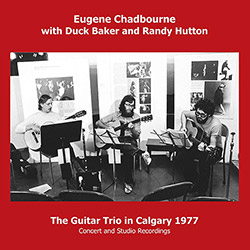
Eugene Chadbourne is, well, Eugene Chadbourne. I am tempted to say you either love him or hate him, but his catalogue is too deep for such stark dichotomy. It spans the gritty, DIY live recordings of country and rock anthems on his own label Chadula to his more aggressive work with John Zorn and so many others to beautiful and deeply abstract, acoustic recordings like the 2019 Wind Crystals. I like to think there is something in his discography for everyone.
The Guitar Trio in Calgary 1977 is a selection of live and studio tracks performed by Chadbourne, Duck Baker, and Randy Hutton over the course of 24 hours in February 1977. Although this period and this trio has been documented before (Volume Three: Guitar Trios, Summer of 77), it is a time particularly in Chadbourne’s development with which I was largely unfamiliar.
With Chadbourne and Hutton on steel stringed acoustic guitars and Baker on a nylon-stringed classical guitar, the music is twangy and dynamic. It is also frequently harsher and less melodic than one might expect, were one to assume Chadbourne and Baker’s deep love of folk music would somehow consume the sessions. (If you are already familiar with the Guitar Trio series, however, the noisy dynamics might not be so surprising.) This album is also quite different from Chadbourne’s experimentalist Shockabilly releases. Though based around some pre-written charts and a few full-scale compositions, the music sounds so much more open, more infused with energy, wide-eyed curiosity, and stubborn determination than many of those country-tinged efforts.
Some tracks, “Cards” (a Roscoe Mitchell composition) and “White with Foam”, are Chadbourne and Baker solos respectively. One, Mary Mahoney, is a duo of Baker and Chadbourne. The rest capture the trio at full acoustic assault. Generally, the result is a jumble of panicked cacophony, racing and broken blues-licks, harsh and tinny steel-stringed shrieks, and transient melodies peppered with softer, abstractly romantic moments. “Ornette Mashup”, with selections from the Coleman compositions “Lonely Woman” and “Comme Il Faut” and the Charlie Haden piece “Song for Che”, is a fine example of Chadbourne, Baker, and Hutton’s unique (har)melodicism buried among the scrapes, strums, flutters, and sheer pluck. One Chadbourne composition, “Two Peafowls”, appears twice on the disc. The first take is an 11-minute live recording that begins with a prolonged fade-in after which it breaks out into a disjointed, amelodic hoe-down. The second is a 27-minute elaboration presumably on those same charts and basic structures recorded in studio. Although each version has its merits, the second is by far the more extreme. It begins with the solitary scraping of springs. Over time, this evolves into a three-man jam session that oscillates between nearly silent troughs of clicks and light brushes, gnarled peaks of acoustic shredding and, at one point, sounds that I could swear were electronic manipulations were this album not so brazenly and purely acoustic.
It can be tempting to dismiss archival recordings like this as juvenilia, snapshots of an artist’s youth before he gained the discipline, chops, and direction that characterize his musical maturity. Although this does offer a glimpse into the early days and ideas of three musicians who were clearly on the vanguard at the time, Guitar Trio 77 can hardly be so flippantly dismissed. On the one hand, it showcases another side to Baker, who has since mastered a variety of styles ranging from Celtic ballads to blues/folk/bluegrass to Monk tunes to contemporary improv. It attests that Hutton, whose output has been limited, was formidable in his own right. And, it shows that Chadbourne had those chops and that balance between free exploration and discipline that, according to Baker’s liner notes, “can actually help to open things up.” It also documents that even at such a young age, Baker and especially Chadbourne were engaged in a relentless pursuit of multidirectionality that they have maintained into maturity. This is more than a thirty-year old archival release. Had I not known the story behind this release, I might have thought this was recorded just this year, that at last the acoustic guitar was getting renewed limelight in free music.
To return to my original point, this music may not be for everyone. But, if you want to hear three visionary guitarists pushing their acoustic instruments far beyond their idiomatic limits, this is it. And it is good. Damn good.
Comments and Feedback:
|



